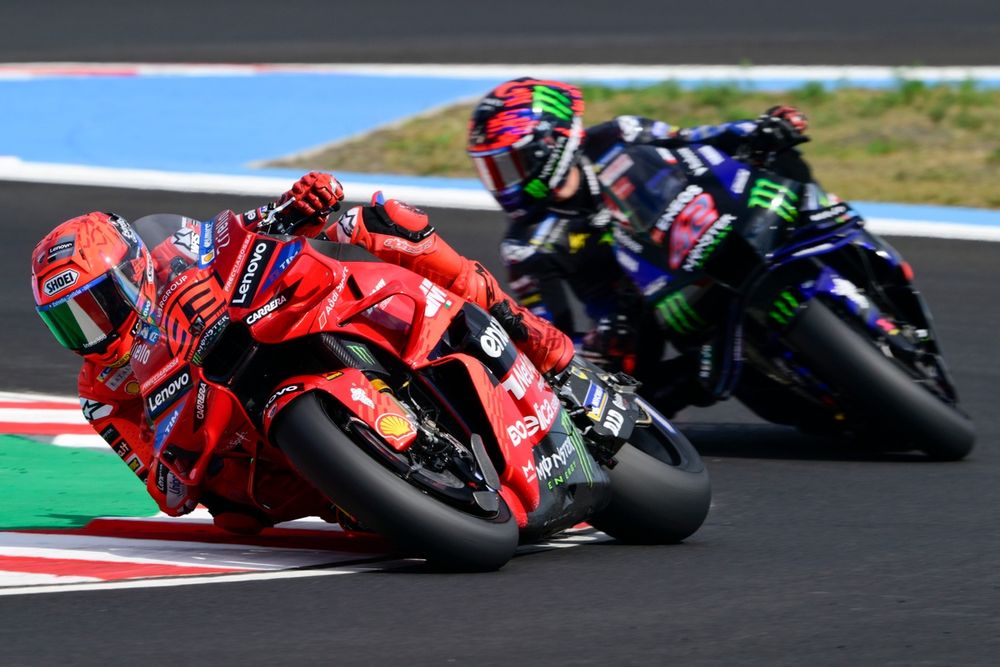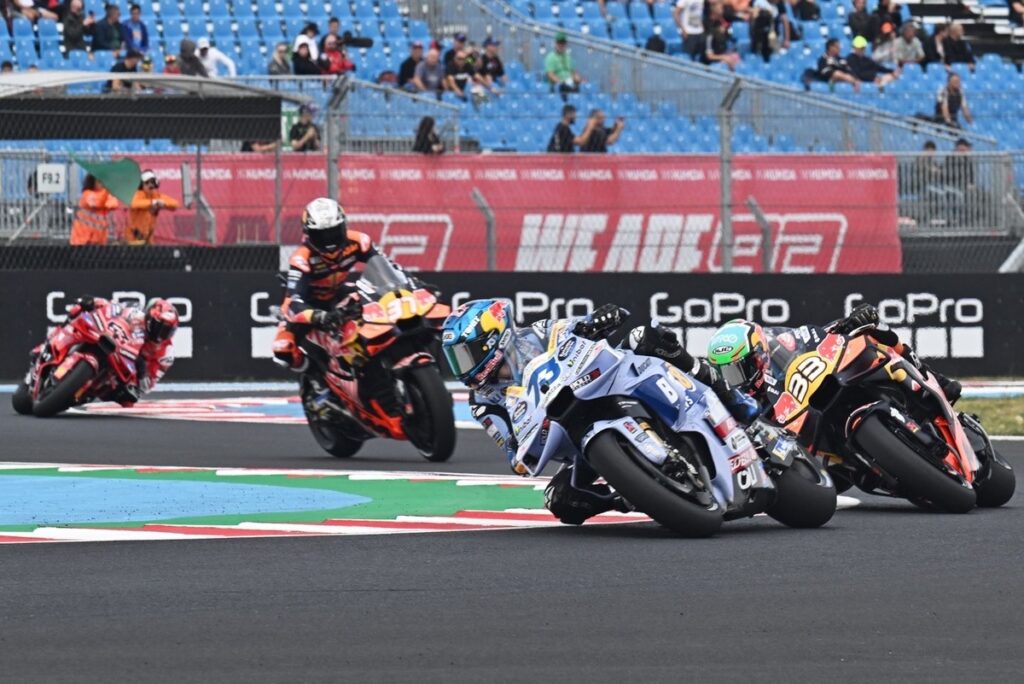The day has come and gone at last. After months of doomtalk around the all-new Balaton Park circuit, MotoGP folk can stop speculating. While the first day of track action at the Hungarian Grand Prix certainly didn’t answer every question that had been doing the rounds in the lead-up, at least there were real MotoGP laps in the record books by the end of it.
So, after 21 bikes shared the circuit on a mild, windy day, we now have opinions based on something more than on a PlayStation or tests with road bikes. And we’ve had a glimpse of what a race around the anti-clockwise layout might look like.
First, a quick recap of the general perception around Balaton Park coming into the weekend. It would, in the finest traditions of Hungarian race tracks, be excessively tight. Overtaking would be next to impossible and this would lead to riders pushing beyond the edge of the envelope in their quests to maximise qualifying. Many would do the same early in the races. That, in turn, raised a couple of whispered safety questions.
So how did the day actually unfurl? From the outside looking in, things were relatively undramatic compared to any other MotoGP weekend.
The only red flag was caused by one of two Aprilia engine failures in the morning (Jorge Martin and Raul Fernandez were the victims) rather than any silly riding or circuit issues.
There were three falls in the morning (Franco Morbidelli doubled up) and two in the afternoon. Nothing remarkable. The track surface itself was offering enough grip – and, it must be said, asphalt run-off areas – for most riders to stay upright most of the time.
Jorge Martin, Aprilia Racing
Photo by: Gold and Goose Photography / LAT Images / via Getty Images
There was only one serious case of riders tripping over each other, as Fabio di Giannantonio got in the way of Alex Marquez, who in turn baulked both Jack Miller and Francesco Bagnaia, resulting in a brief period of gesticulation and ill will. And that may simply have been down to first-day unfamiliarity rather than the start of a weekend-long trend.
“When it’s a new track, it’s difficult for riders to know where to stop or where to avoid that kind of problem,” explained Alex semi-apologetically at the end of the day.
The 17 corners – many of them flappity-flop chicanes – come thick and fast on MotoGP bikes, which gobbled them up in under 100 seconds. Television viewers prone to seasickness are advised to look away during on-board camera shots this weekend. But the riders didn’t find Balaton Park at all ridiculous, generally giving the circuit the thumbs-up despite all those fears coming into the first Hungarian GP since the Budapest races in the 1990s.
World champion Martin described the layout as “fun.” KTM’s Brad Binder called it “pretty neat” as well as “sick” (though not in the sort of way that strikes on a rolling boat). Morbidelli bore the circuit no grudge despite his tumbles, saying, “I like the track.”
Points leader Marc Marquez took some winning over at first. Although he then made his peace with the track and was only six thousands of a second off Pedro Acosta’s pace at the end of practice, he obliged the media by referencing a certain form of junior motorsport many had used to disparage the layout in the build-up.
“I didn’t enjoy FP1 because it was super tight,” said Marc. “I mean everything arrived super fast, it was like karting. But then you get used to it. In the end, it’s a bike on a circuit. A slower circuit, but a different layout and we must adapt.”

Marc Marquez, Ducati Team
Photo by: Gold and Goose Photography / LAT Images / via Getty Images
What did come in for targeted criticism, to varying degrees, were some of the three ultra-tight chicanes. “The chicanes are insanely slow, so it took a lot of getting used to,” said Binder. “They are super Mickey Mouse. That’s the only thing that I can’t say I enjoy too much.”
Fernandez was also outspoken about the tortuous, one-line switchbacks, which certainly weren’t a good look on television. Apart from their general lack of appeal, he also saw them as a potential trouble spot.
“We have two chicanes that are not really nice on the MotoGP bike,” said the Trackhouse Aprilia man. “They are super slow. If you are alone, I think it’s not really bad. But when you arrive there with 20 bikes around you, it will be very difficult to manage. Especially because if you crash on the first [part], I don’t think you have enough space to stop the bike.
“I think if you crash, the bike will arrive to the second chicane. I think the circuit is safe, but at these two points, I think they have to find a solution for the future. Because these two chicanes, I think, are not the best for the track, and also [not] for the show.”
Ah yes, what about that show then? At least the riders didn’t unanimously dismiss the notion of any overtaking at Balaton Park in the races on Saturday and Sunday.
While some subscribed to the popular notion that there would only be one line and qualifying would be paramount, an upbeat Martin – who edged his team-mate Marco Bezzecchi and only narrowly missed out on Q2 – listed as many as four potential passing spots, including two of the chicanes.
“It will be difficult, but Turn 1, Turn 5, Turn 9 and maybe Turn 15 are good spots to overtake,” said the Spaniard. “But for sure it’s risky because it’s really narrow and easy to go wide.”
Marco Bezzecchi, Aprilia Racing
Photo by: Gold and Goose Photography / LAT Images / via Getty Images
Marc Marquez emphasised those risks in his assessment of overtaking possibilities: “In one way it looks like it’s easy to overtake because there are a lot of braking points. But in another way, it’s easy to make a big mistake. A big mistake means creating some collision or just trying to overtake somebody and losing the front. Overtaking will be difficult.”
One thing that was noticeable on the first day was the number of riders outbraking themselves and making use of the various run-off areas and escape roads. While some of this may be down to the usual process of finding the limits on the first day at a new track, Marquez doesn’t think it will go away: “I think it will be a lot of – as we saw in practice – riders missing the corners. A lot of riders missing the braking points.”
Indeed, it was hard to shake the feeling on day one that entertainment during the races will come largely in the form of mistakes. Marquez says that racer’s instinct will ensure at least a few of those come along. Especially early in proceedings.
“I think [the riders] already understand; they will be careful. But always [there are] one or two or three riders – or even me – who want to overtake one or two on the braking points. Then that is the dangerous point. But [with] adrenaline there it can happen. But in the end the circuit is safe, that’s the most important thing.”
All told, Balaton Park probably had as good a first day as its bosses could have hoped for. The chicanes were always going to earn the wrong kind of attention from some riders. But generally positive rider feedback and minimal criticism on the safety front is a decent result. And there’s hope of a reasonably entertaining weekend – even if the action comes in the form of optimistic lunges going horribly wrong.
It does need to be said that Balaton Park is never going to be a winner on the aesthetic front. Flat and featureless, with no views of Lake Balaton in sight, the television viewer would be forgiven for confusing it with Qatar. Whether or not the backdrop matters is open to debate, but the quality of the racing will be the biggest factor in this track’s post-weekend report card. Saturday and Sunday will be the ultimate test of whether the cynics were right or wrong.
In this article
Be the first to know and subscribe for real-time news email updates on these topics
Read the full article here

